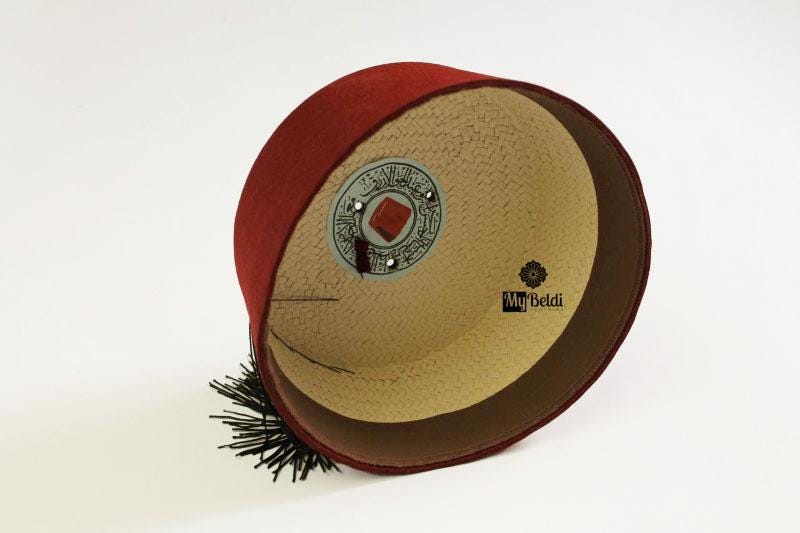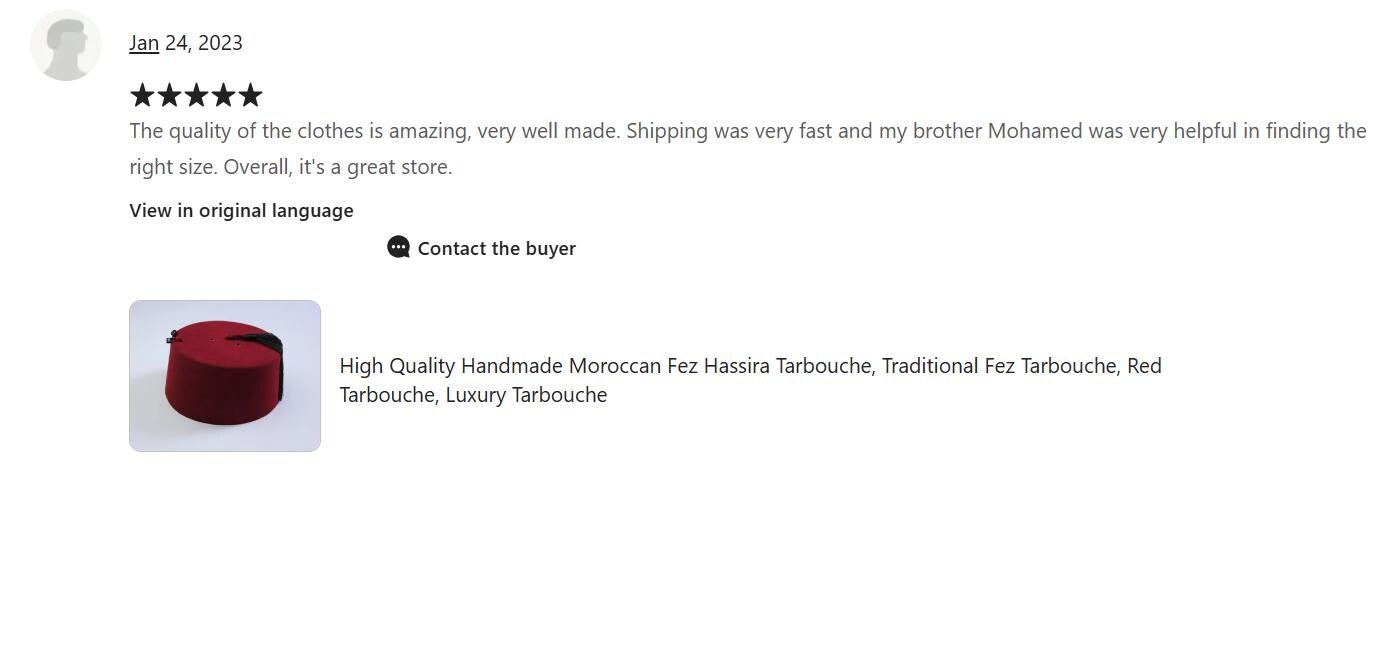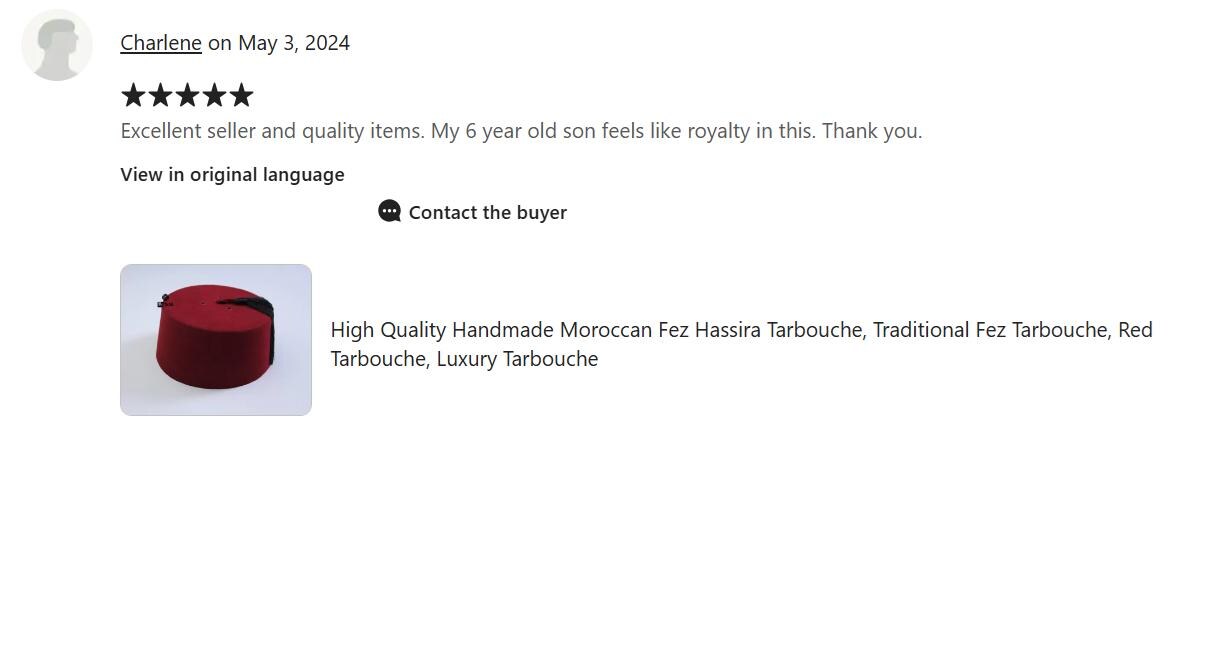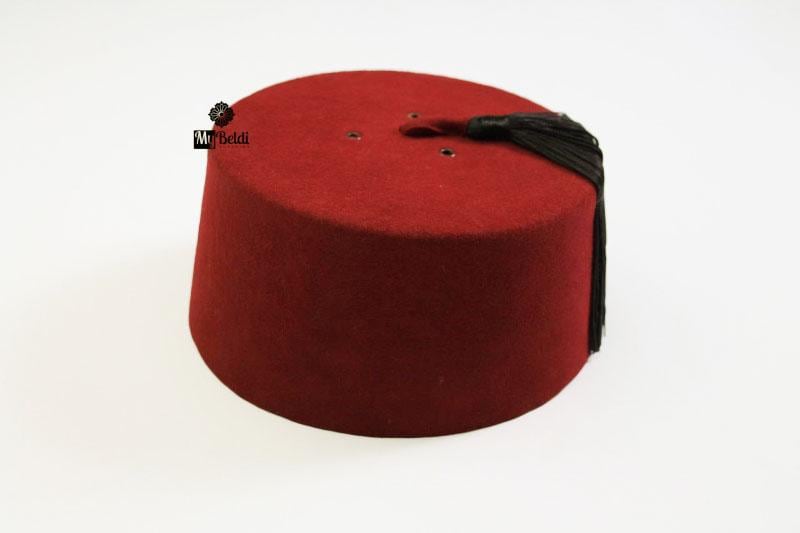What Is the Fez Hat Tarbouche Hassira?
The Fez Hat Tarbouche Hassira is a flat-topped, cylindrical hat with deep historical roots in Morocco and North Africa. It has been a staple in men's traditional dress for centuries and is still widely recognized as a symbol of identity and elegance.
Crafted in a rich crimson hue, the Fez Hat is distinguished by its structured form and black tassel that elegantly falls to one side. This simple yet commanding design reflects centuries of cultural significance and refinement.

The fez isn’t just worn for style; it conveys a message of respect, dignity, and tradition. The Fez Hat Tarbouche Hassira is often seen at weddings, religious holidays like Eid, weekly Friday prayers, and important national or community gatherings. Its presence signifies formality and honor, elevating the wearer's attire to reflect cultural awareness and pride.
While the hat is a staple in Moroccan culture, its versatile design also makes it a unique accessory for anyone looking to embrace North African fashion, regardless of heritage. Many choose it as a statement piece or a thoughtful gift for fathers, brothers, or elders, making it both fashionable and meaningful.
A Hat with History
The Fez Hat originates from the ancient city of Fes, one of Morocco’s most spiritually and intellectually significant cities. Its name directly references this city, where the design was first developed and worn by local scholars and leaders. Over time, the fez spread beyond Morocco, gaining popularity across the Ottoman Empire and throughout the Arab world. It became a key part of official dress codes for statesmen, judges, religious figures, and even military personnel. In Morocco, the Hassira style of fez developed into a more structured and ceremonial version of the hat. This variant is stiffer, more formal, and typically reserved for special events and formal appearances. The Fez Hat is commonly paired with garments like the djellaba, jabador, or thobes, including the gandoura and caftan. Together, they form an ensemble that represents grace, identity, and adherence to tradition.
Explore matching garments in our:
Handcrafted by Moroccan Artisans
At My Beldi Clothing, each Fez Hat Tarbouche Hassira is handmade by skilled Moroccan artisans using traditional methods passed down through generations. These artisans are guardians of a rich heritage and take pride in preserving the integrity of Moroccan design.
Made from high-quality felt, the hat boasts a firm, structured shape and a luxurious finish. The deep red tone is achieved through a natural dyeing process that enhances the authenticity of each piece. The felt is soft to the touch yet durable, ensuring that the hat maintains its form even after years of use.
Every hat is carefully constructed with attention to detail. From the perfectly shaped crown to the hand-tied black tassel, every element of the fez is designed with precision. The meticulous stitching enhances the hat’s durability, while the inner lining provides comfort for extended wear.
The artisans who create these hats do so with an understanding of their cultural importance. Their work is not just craft, but legacy—an expression of Moroccan identity woven into every fiber.

The Symbolism Behind the Fez
The fez hat carries deep symbolic meaning that extends far beyond its physical appearance. In Moroccan society, it represents knowledge, spirituality, status, and cultural pride. It is frequently worn during important religious occasions, such as Friday prayers and Eid, where it serves as a visible reminder of reverence and humility before God.
The red color of the fez is historically linked to themes of sacrifice, valor, and nobility. It is a bold color that draws attention while still maintaining a sense of decorum. The tassel—always black and positioned to one side—symbolizes a thread of connection to spirituality, tradition, and wisdom passed down through generations.
Even today, the fez is more than a nostalgic piece of attire. It acts as a cultural bridge, allowing wearers to feel connected to their heritage while still expressing individuality and style. In many families, the fez is passed from father to son, becoming a cherished heirloom.
Global Influence & Evolution
Though deeply rooted in Morocco, the Fez Hat Tarbouche Hassira has had a significant influence on fashion and identity across many regions of the world. During the time of the Ottoman Empire, the fez became a widespread symbol of intellectual and religious authority. It was often incorporated into the official uniforms of the Ottoman court and military.
In North Africa, it found its place in formal and ceremonial military dress, especially in Algeria and Tunisia. Its appearance in these contexts gave it a reputation for prestige and order.
In modern times, the fez continues to make its mark globally. It has been featured in international cinema, literature, and even pop culture, often symbolizing wisdom or traditional roots. Many contemporary designers are reimagining the fez in new materials and modern silhouettes, merging it with contemporary fashion trends.
Today, wearing a fez hat is a subtle but powerful way to acknowledge tradition while participating in a global fashion movement that celebrates cultural diversity.
How to Care for Your Fez Hat
To ensure your Fez Hat Tarbouche Hassira remains in perfect condition, proper care is essential. This timeless accessory can last for many years if maintained with attention and respect.
Follow these care tips:
- Dust regularly using a soft, dry brush to remove particles
- Avoid moisture and do not expose the hat to rain or high humidity
- Keep away from direct sunlight to prevent color fading
- Store carefully in a hat box or on a flat surface to retain shape
- Tassel maintenance: Gently straighten the tassel and keep it free of knots
With these steps, your fez will continue to look elegant and hold its shape, whether displayed at home or worn for formal occasions.
How to Style the Fez Hat
The Fez Hat Tarbouche Hassira is incredibly versatile and can be styled in many elegant and meaningful ways:
- For Eid celebrations: Pair the hat with a traditional white Mlifa djellaba or a well-tailored thobe to create a clean, ceremonial look.
- For weddings: A richly embroidered jabador complements the formality of the fez, adding an extra layer of cultural elegance to your ensemble.
- For cultural fusion: Match the fez with a modern blazer or smart suit to blend tradition with contemporary style, perfect for events or fashion-forward appearances.
Each pairing brings out a different aspect of the fez's personality, from deeply spiritual to classically stylish.
Customer Testimonials & Real Stories
Real Reviews from Etsy

These reviews reflect the joy and satisfaction our clients experience when receiving and wearing their Fez Hat Tarbouche Hassira.
Where to Buy It
You can order your authentic Fez Hat Tarbouche Hassira directly from our shop: 👉 Buy Now
- Ships internationally
- Ethically handmade in Morocco
- Trusted by hundreds of happy customers
The Fez Hat in the Moroccan Diaspora
For Moroccans living abroad, the fez serves as more than a traditional accessory—it’s a strong connection to homeland and heritage. Whether worn in the United States, the United Kingdom, France, or Canada, it holds the same emotional weight and cultural significance.
During special occasions like Eid, weddings, or Moroccan national holidays, wearing a fez brings a sense of pride and belonging. It is a visual reminder of one's identity and an expression of respect for the values and customs passed down through generations.
In diaspora communities, the fez is also gaining popularity among the younger generation, who wear it proudly at family gatherings and community events. It bridges generational gaps and sparks conversations about ancestry and cultural continuity.

